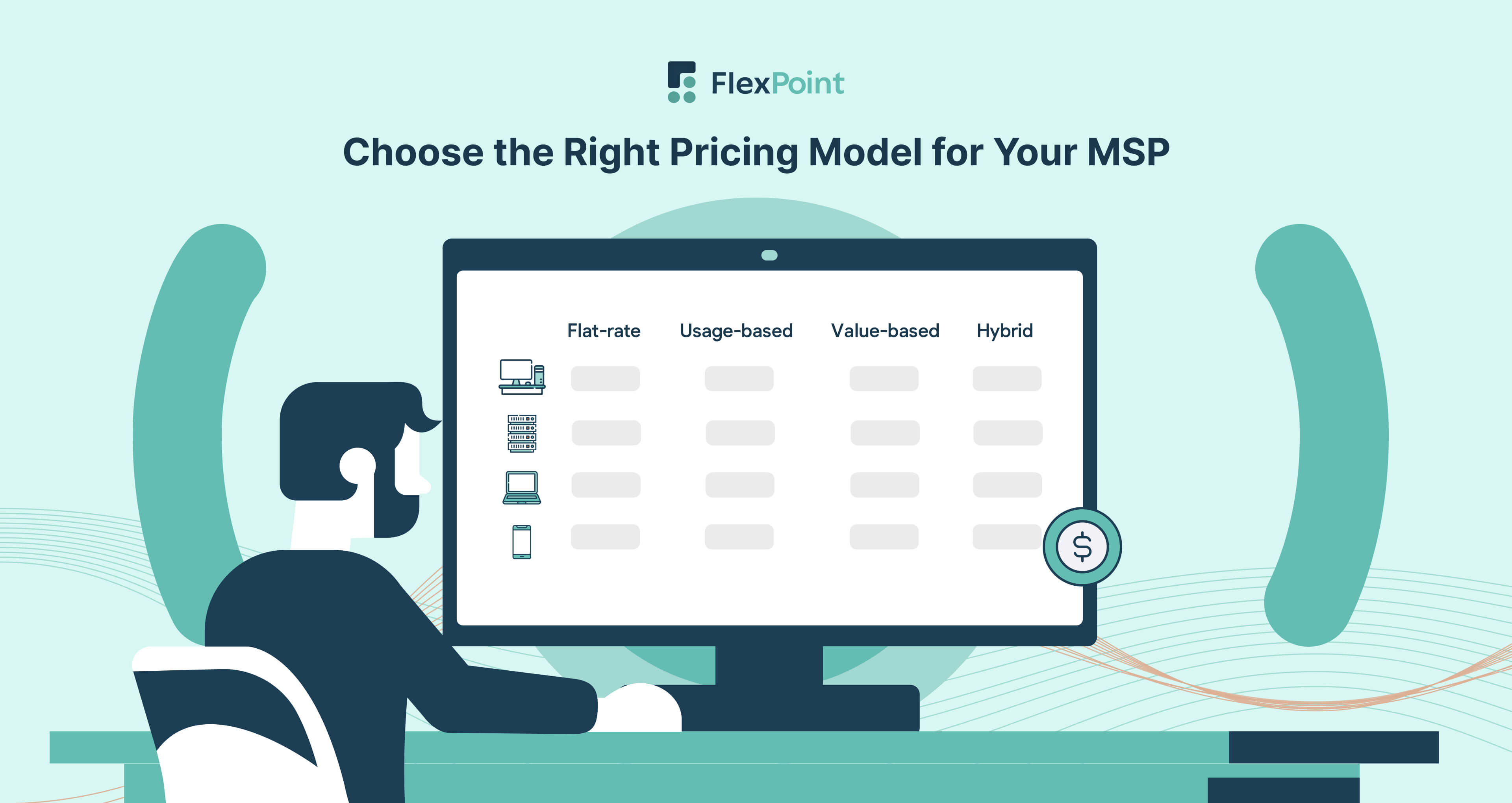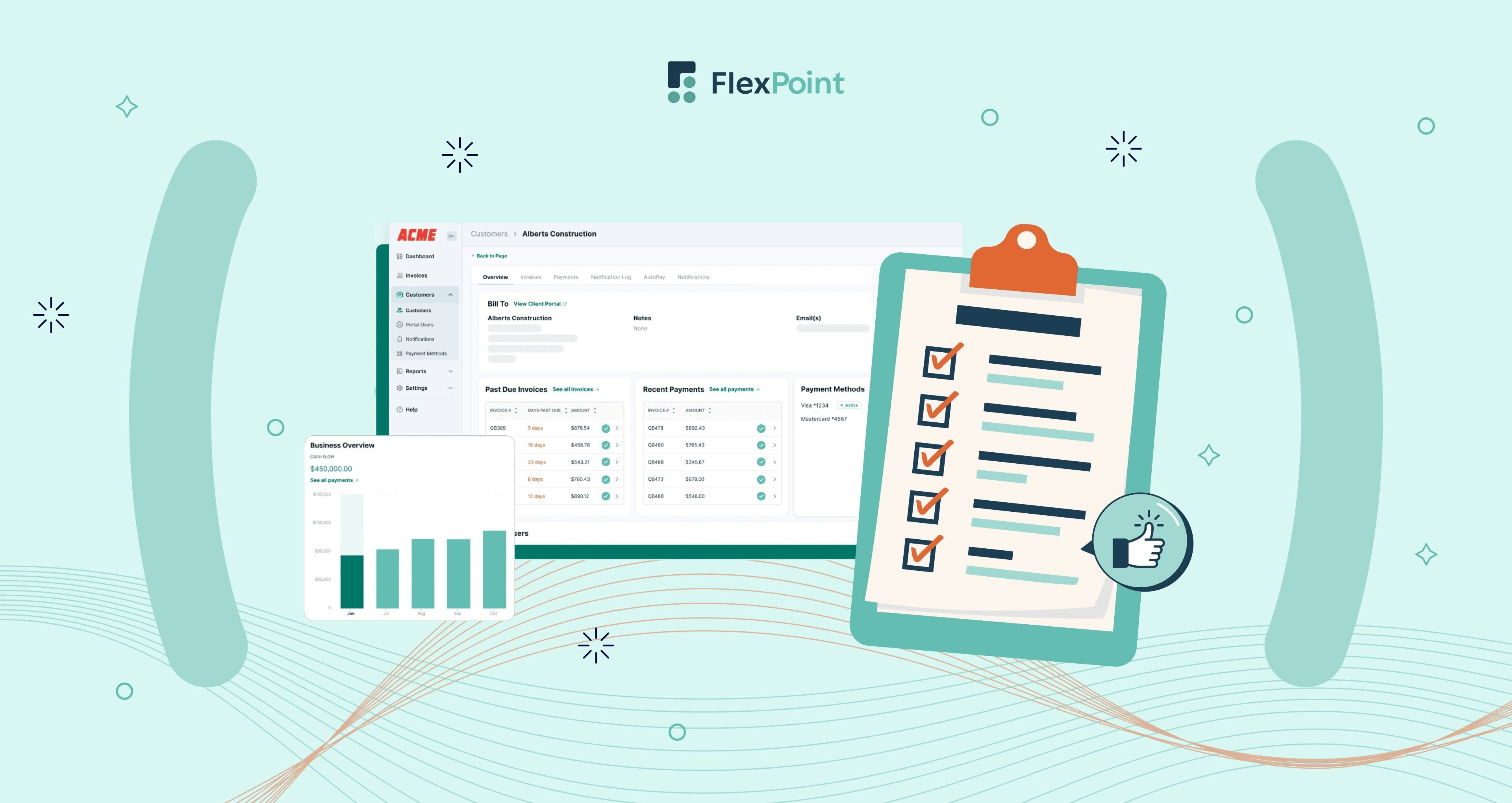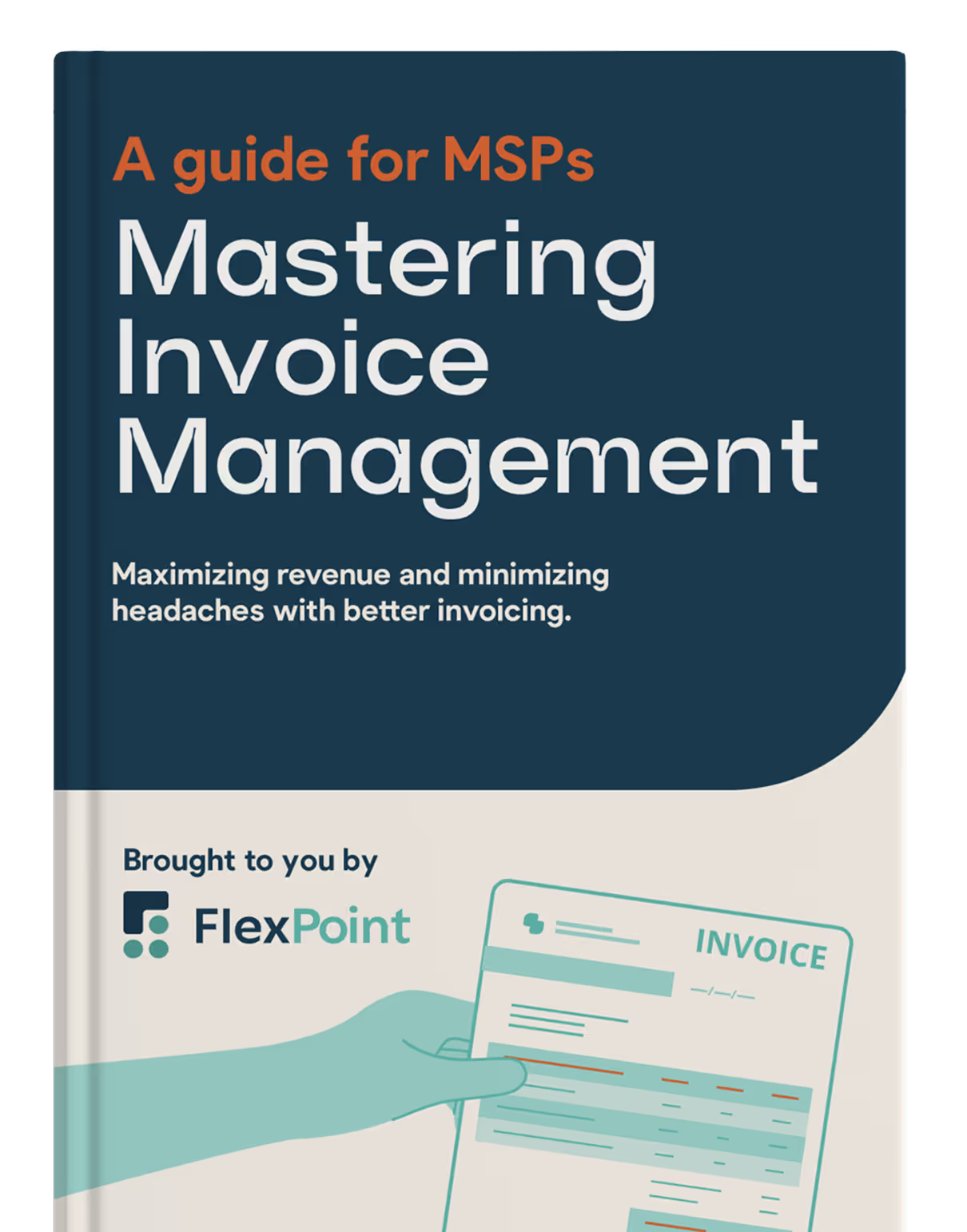MSP Flat Rate All-Inclusive Pricing: A Simpler Model for Service and Billing
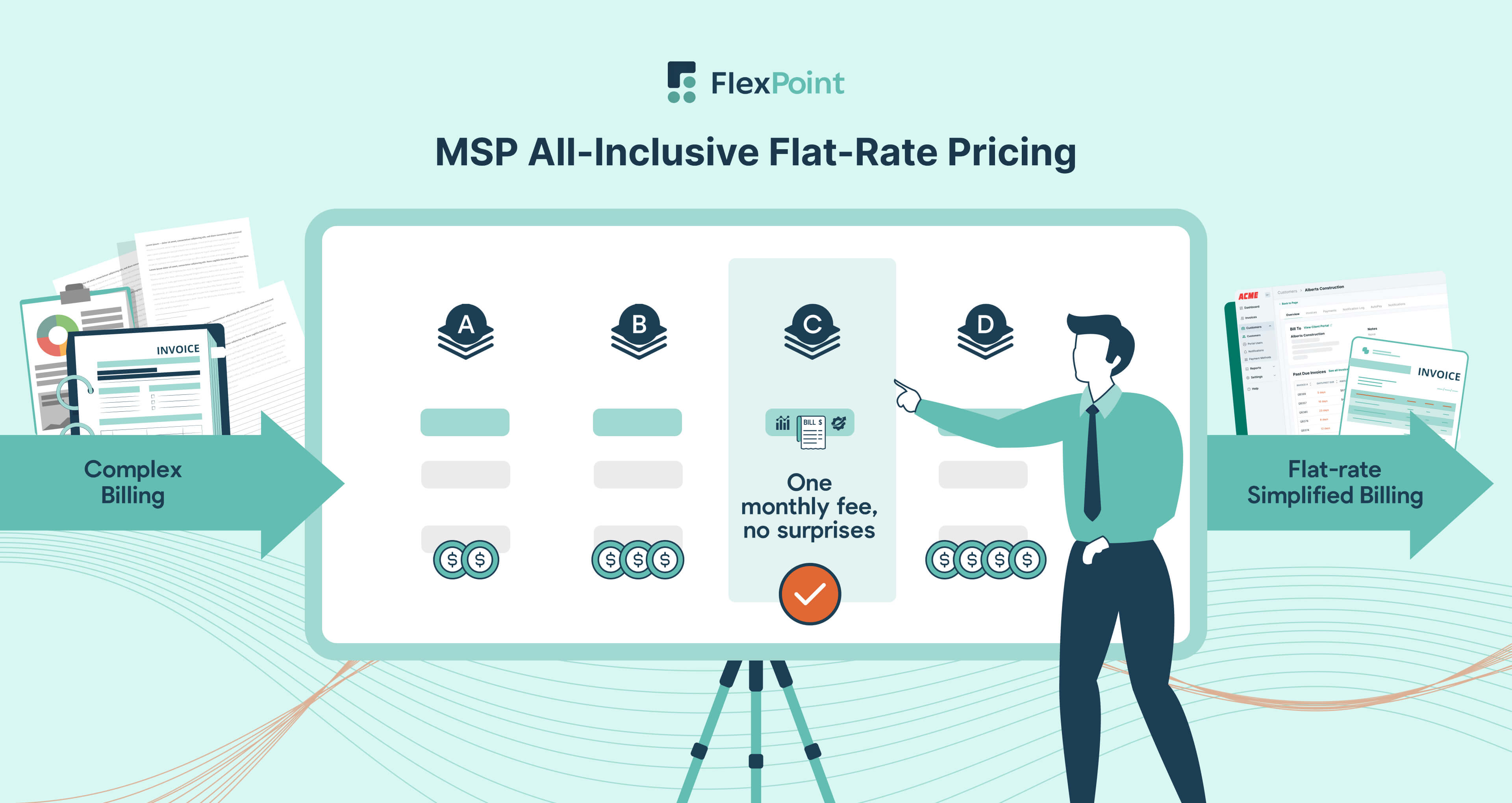
Many managed service providers (MSPs) are moving away from hourly billing and toward flat-rate all-inclusive pricing, and for good reason. This model provides a straightforward, subscription-style approach that simplifies billing, fosters client trust, and generates stable, recurring revenue. Instead of counting hours or logging tickets, the MSP charges a fixed monthly rate that covers a clearly defined set of services.
For clients, it means no surprise invoices or fluctuating IT bills. For MSPs, it means greater consistency in revenue and fewer billing disputes to manage. The model enhances financial predictability and alters how MSPs interact with their clients. It shifts the focus to long-term results rather than reactive support.
This model is especially appealing in today’s subscription-driven economy. Many clients want IT support to work the same way as other services—one flat rate, clear deliverables, and no billing surprises. MSPs also benefit, as fixed-fee billing incentivizes them to become more efficient and proactive.
However, MSPs need to carefully plan before switching to this billing model, including clearly defining the service scope and selecting billing tools that support recurring and flat-rate structures.
In this article, we explain what flat rate all-inclusive pricing involves, its pros and cons, and best practices for building and billing these service packages. We will also discuss how MSP-specific payment automation software helps MSPs automate and manage this model effectively.
{{toc}}
What Is Flat Rate All-Inclusive Pricing for MSPs?
Flat-rate all-inclusive pricing means charging a consistent monthly fee for a bundle of IT services, regardless of how frequently those services are used. This flat (monthly or quarterly) fee covers everything outlined in the agreement.
Typically, this includes:
- Monitoring
- Help desk support
- Patching
- Updates
- Basic cybersecurity
Unlike hourly billing or per-device pricing, the client is not billed based on usage or volume. The focus shifts from the amount of time spent on support to whether outcomes are being achieved. Clients gain predictability, while MSPs reduce the time spent tracking hours or preparing detailed invoices.
However, “all-inclusive” doesn’t mean unlimited. The service agreement must clearly define what is included in the flat fee and what will incur additional charges. For instance, project work, after-hours support, or vendor management might fall outside the scope.
This model is best suited for MSPs that prioritize proactive support and foster long-term client relationships.
Clients don’t need to worry about the cost of each service ticket, and MSPs can operate with consistent income and a streamlined billing process.
Flat-rate models also align with modern client expectations. More clients and businesses prefer service arrangements that mirror their experiences with other subscriptions. From software to cloud storage, clients are used to paying a fixed amount for access to ongoing value.
MSPs who adopt this pricing structure can better meet those expectations and offer a frictionless financial experience.
{{ebook-cta}}
Pros and Challenges of All-Inclusive Flat Rate Pricing
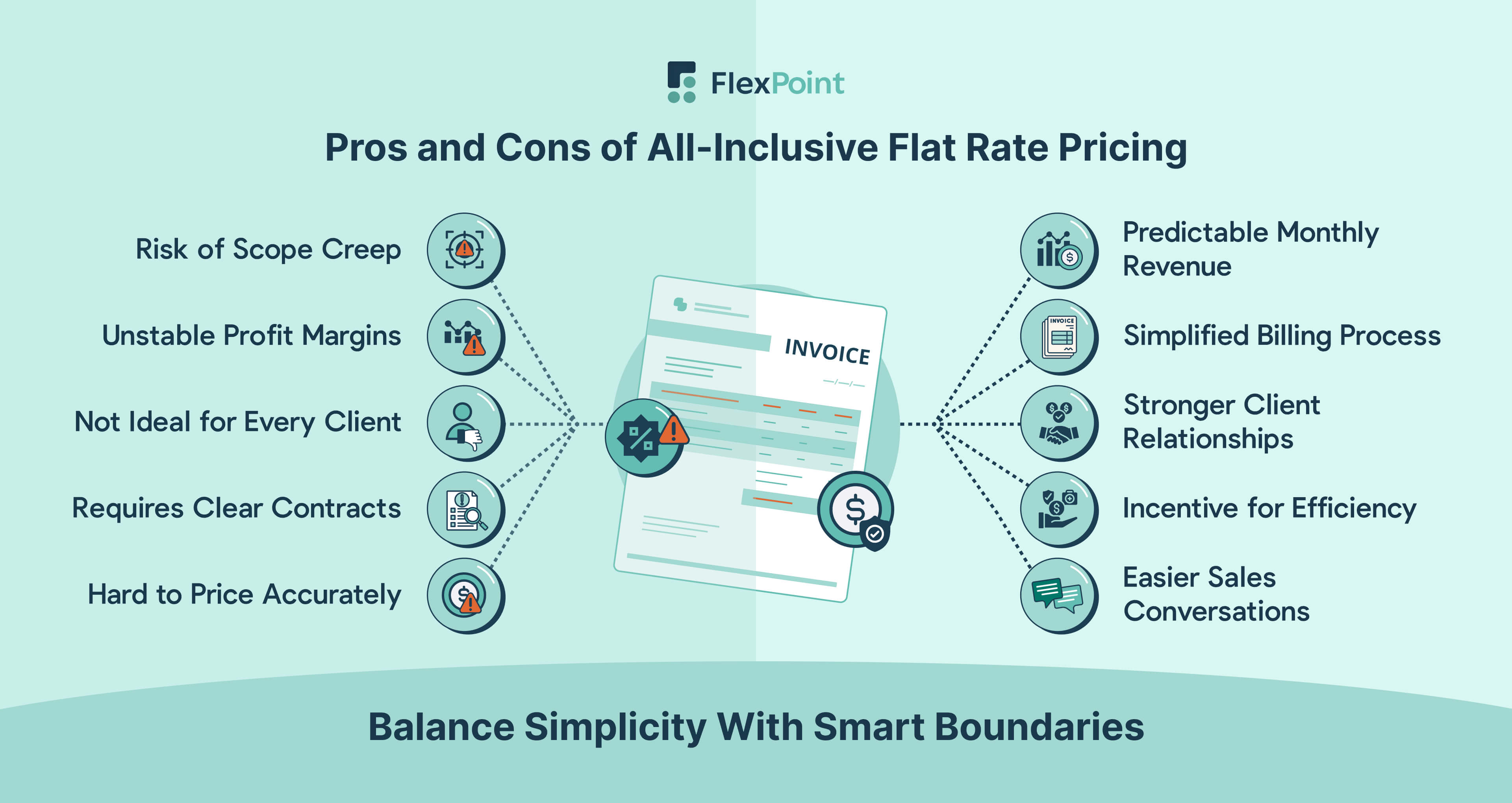
Flat-rate pricing appeals to many MSPs because it simplifies billing and aligns well with client expectations for transparency and predictability. However, like any pricing model, it comes with trade-offs.
While it can stabilize revenue and strengthen client relationships, it also introduces risks if service boundaries aren’t well defined or client usage varies dramatically.
Understanding both the advantages and the challenges is key to deciding whether this model suits your business structure and client base:
The Pros of All-Inclusive Flat Rate Pricing:
- Predictable Revenue: Flat-rate billing provides recurring monthly income, making it easier to manage cash flow and forecast revenue. A steady stream of income also improves long-term planning for the MSP.
- Simplified Billing: A single fee means fewer line items and less time spent preparing invoices. Clients also appreciate the simplicity. They don't have to comb through detailed bills or question every support interaction.
- Stronger Client Relationships: The focus is on outcomes, not hourly tracking. This positions the MSP as a trusted partner. When clients don't feel "on the clock," communication tends to be more open and productive.
- Incentive for Efficiency: Because revenue is fixed, the MSP is motivated to automate, improve processes, and reduce reactive work. This can lead to better service delivery overall.
- Reduces Friction in Sales Conversations: Prospects often hesitate to commit when they fear unpredictable costs. Flat-rate pricing removes that concern and helps shorten the sales cycle.
The Cons of All-Inclusive Flat Rate Pricing:
- Scope Creep: Without clearly defined service boundaries, clients may expect more than what the contract allows. This can increase the workload without additional compensation.
- Profit Margin Risk: If a client requires more support than anticipated, the flat fee may not fully cover the costs. MSPs need to assess usage patterns before setting rates.
- Not Ideal for Every Client: Clients with fluctuating or seasonal needs might not be a good fit. The model assumes relatively steady demand.
- Contract Clarity is Mandatory: A well-written agreement must clearly outline what is included, what is excluded, and how additional work is billed.
- Difficult to Set Pricing Initially: New MSPs or those without detailed service records may struggle to determine the optimal monthly fee. Pricing too low can lead to losses; pricing too high can scare off clients.
Flat-rate pricing works well when MSPs have systems in place to track labor, document services, and manage exceptions. Without these, it can be challenging to determine when the model is incurring a loss.
When Flat Rate Pricing Makes the Most Sense
This flat rate all-inclusive billing model is most effective in scenarios where IT needs are stable and predictable. For example:
- Clients with no internal IT: Businesses that rely entirely on the MSP for day-to-day support are ideal candidates. They often lack the in-house expertise or bandwidth to manage systems on their own. These organizations value comprehensive coverage and require a dependable partner who can serve as an extension of their team, providing stability, technical expertise, and prompt issue resolution across their operations.
- Clients that prioritize budget stability: Flat fees help clients and organizations avoid unexpected costs, which is crucial for planning and cash flow. For many small and mid-sized businesses, this model eliminates the anxiety of fluctuating IT bills and makes it easier to forecast expenses over time. Predictable monthly costs allow their leadership teams to focus on strategic goals without the distraction of managing shifting IT invoices.
- MSPs with mature operations: If you have clear documentation, a reliable service technician team, and efficient processes in place, a flat-rate model is easier to sustain. Mature MSPs typically have detailed knowledge of their service delivery costs and ticket volumes, making it simpler to set appropriate monthly pricing. These firms are also more equipped to enforce scope boundaries and deliver consistent service without relying on reactive support models.
- Established client relationships: High-trust clients that communicate openly are more likely to respect scope boundaries and engage collaboratively. These relationships often come with a history of service delivery, mutual understanding, and aligned expectations. With transparency on both sides, flat-rate agreements can strengthen the partnership by reducing administrative friction and reinforcing shared accountability.
- Clients focused on strategy, not transactions: Flat-rate clients are often more interested in business outcomes than granular time reports. Rather than worrying about every support request or cost breakdown, they want IT to drive efficiency, security, and growth. This enables the MSP to focus on delivering measurable results, such as increased uptime, productivity improvements, or risk mitigation, rather than tracking every ticket or billable hour.
When and Where Flat Rate Pricing Is Not A Good Fit
Flat-rate pricing is less suitable for:
- Clients who need occasional or one-time support: Businesses that require infrequent assistance may find flat-rate plans unnecessary or too costly. These clients often prefer to pay per incident or on a project basis, especially when their IT needs are minimal or unpredictable.
- Organizations with highly variable workloads month to month: Companies whose support needs fluctuate widely may struggle to justify a fixed monthly fee. During quieter periods, they might feel they’re overpaying, which can lead to dissatisfaction or contract churn.
- New clients without a track record of support usage: Without historical data, it’s challenging to accurately estimate how much support a new client will need. MSPs risk underpricing or overcommitting in the early stages of a relationship where expectations haven’t yet been defined.
- Environments that require frequent large-scale projects or changes: Flat-rate agreements are not designed to cover major one-off projects, migrations, or infrastructure overhauls. In these environments, the constant demand for large-scale changes can quickly exceed what’s sustainable under a fixed-fee model.
For the model to work well, both parties (the MSP and the client) should have aligned expectations, shared goals, and a track record of consistent communication. That’s when the predictability and value of flat-rate pricing become most impactful.
6 Best Practices for Structuring and Billing Flat Rate MSP Services
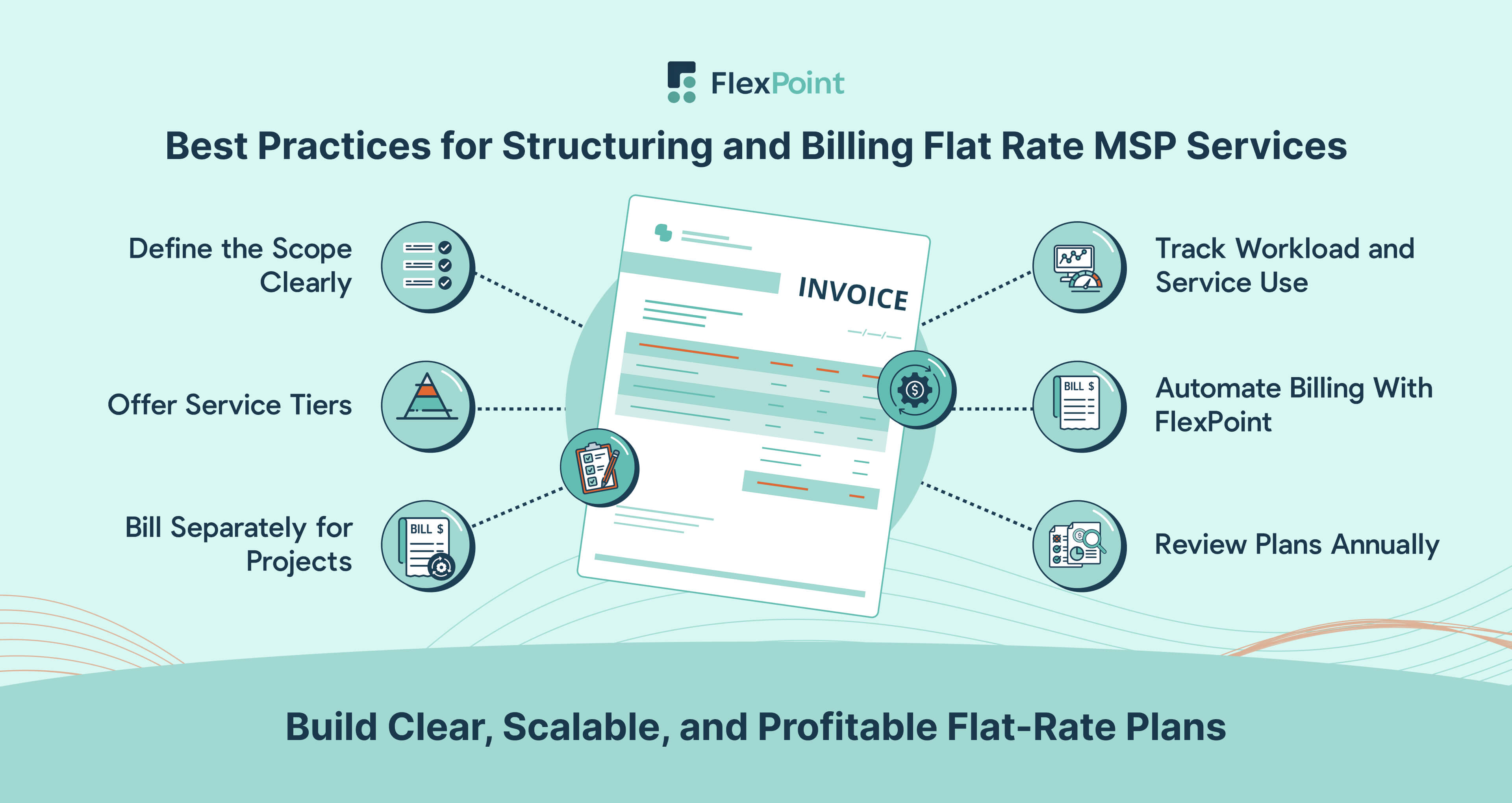
To make flat-rate pricing successful, structure your offerings with care:
1. Define the Scope Clearly:
List every service included in the flat fee and document any exclusions. Use your agreement to establish clear expectations and prevent misunderstandings. This should also include clear language around hours of operation, escalation procedures, and service tiers.
2. Offer Service Tiers:
Different clients have different needs. A tiered model (basic, standard, premium) helps you scale support without overpromising. Each tier can offer predefined services that suit different organizational sizes and complexity levels.
3. Bill Separately for Projects:
Don’t include major one-time efforts in your flat fee. Quote and bill these separately. Even loyal clients understand that a new office setup or cloud migration may require additional resources.
4. Track Workload and Service Use:
Monitor support tickets and hours spent per client. Use this data to validate pricing and identify when a contract needs review. Set usage thresholds internally to flag overages early.
5. Automate Billing:
A payment tool like FlexPoint simplifies recurring invoices and lets you set rules for flat-rate services. It can also bill out-of-scope items separately. FlexPoint’s automation helps ensure no charges are missed and invoices are accurate each cycle.
6. Review Plans Annually:
Flat-rate agreements should be reviewed at least once a year to ensure they remain accurate and up-to-date. Client needs change, and pricing must reflect usage, value delivered, and service expansions.
Consistent billing practices not only protect your margins but also build client trust. Automation helps reduce manual errors and saves time each month. It also enables better transparency when a client requests a breakdown of services.
Conclusion: Simplify Operations and Scale With All-Inclusive Pricing
Flat rate all-inclusive pricing helps MSPs simplify billing, build stable revenue, and strengthen client relationships. It aligns well with clients who want predictability and outcomes rather than hourly details. At the same time, it challenges MSPs to define scope clearly, manage resources wisely, and monitor profitability over time.
For MSPs ready to scale and improve operational efficiency, this model can be a smart move. It supports long-term contracts, encourages automation, and provides clients with a single, consistent budget number for each month.
FlexPoint makes the shift easier. The platform supports recurring flat-rate billing, separate invoicing for out-of-scope work, and usage-based tracking. These tools help MSPs avoid profit erosion while delivering predictable value to their clients.
Finally, FlexPoint integrates with common PSA platforms (such as ConnectWise, AutoTask, SuperOps, HaloPSA) and accounting platforms (QuickBooks Online, QuickBooks Desktop, Xero ), allowing MSPs to centralize their billing and reporting in one place. This reduces reconciliation issues and creates audit-ready records with minimal effort.
FlexPoint also features a customizable, branded payment portal that gives clients a clear, professional payment experience, strengthening your brand and improving cash flow.
Thinking of adopting all-inclusive flat rate pricing?
FlexPoint makes it easy to bill, track, and manage predictable service packages.
Schedule a demo to see how FlexPoint supports scalable MSP billing strategies.
{{demo-cta}}
Additional FAQs: MSP Flat Rate Pricing
{{faq-section}}



